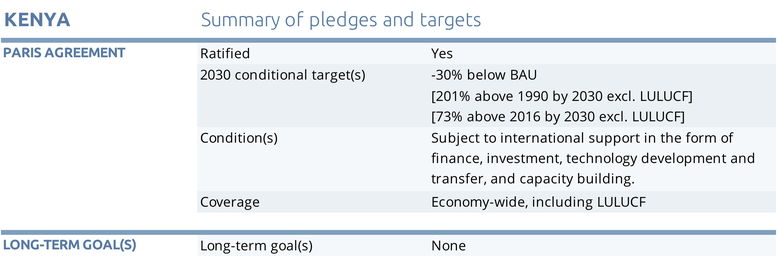Pledges And Targets
Summary table

Paris Agreement targets
Kenya ratified the Paris Agreement on 28 December 2016 (MENR, 2017b). Kenya seeks to abate its greenhouse gas (GHG) emissions by 30% by 2030 relative to the business as usual (BAU) scenario of 153 MtCO2e (143 MtCO2e using IPCC SAR values) including LULUCF and 131 MtCO2e, if LULUCF is excluded. The target is conditional on international support (MENR, 2015).
According to our assessment of current policies, Kenya’s is on track to meet, and even overachieve its Paris Agreement pledge according to the upper and the lower range of the current policy pathways, respectively.
If one were to recalculate Kenya’s NDC based on the lower range of current policy projections, it would increase its ambition from 110 MtCO2e/yr excl. LULUCF to 89 MtCO2e/yr excl. LULUCF. If we were to translate this emissions level to the language of Kenya’s NDC, this would be a reduction of 44% below BAU, including LULUCF. In preparation for its NDC, bottom up sectoral analysis determined that Kenya has the potential to reduce emissions by 60% below BAU. There is significant scope for Kenya to adopt an unconditional target as well as scale up its conditional target with international support.
The abatement contribution of various sectors to the 30% reduction varies. The LULUCF sector contributes the largest share (47%) to the overall emissions reductions target, with all the remaining sectors together contributing 53%. The electricity supply subsector contributes the second largest share (22%), followed by the energy demand (14%) and the transport subsector (8%). Agriculture (6%), industrial processes (2%) and waste (1%) contribute the rest (MENR, 2017b).
After excluding LULUCF and considering its disproportionately high share of the total emissions reductions target, Kenya’s maximum GHG emissions limit (excl. LULUCF) in 2030 is 110 MtCO2e. See the Assumptions for further details.
Considering the fact that the bottom up sectoral analysis, prepared as part of developing its NDC identified the potential to reduce projected emissions by 2030 by 60% (MENR, 2017b), i.e. twice as high as the current conditional target, there is potential for Kenya to strengthen its conditional target as well as adopt an unconditional one.
Kenya is planning to enhance and update its NDC by 2020 (WRI, 2019).
Further analysis
Latest publications
Stay informed
Subscribe to our newsletter




